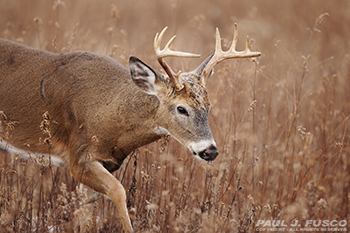Conflicts with Deer
Management of Conflicts
Deer involved in conflicts with humans can be controlled using a number of methods, such as fencing, repellents, and preventive measures.
Fencing: Electric high-tensile wire fences such as the 7-strand slant wire, the 6-wire vertical fence, and others have been designed to protect crops from deer damage. Spacing between wires should be about eight to 10 inches and any brush around the fence should be cleared away. The type of fence to construct depends on such factors as terrain, vegetation, location, and deer density. For more detailed information on electric fences, contact the Wildlife Division at deep.wildlife@ct.gov or 860-424-3011.
Woven-wire fences may also be used to keep deer out of an area, and cattle fencing or chicken wire fences will work if constructed eight to 10 feet high. Wire strands strung above the woven wire can add more height if desired. Wire mesh fences may be erected around individual ornamentals or other plants you might wish to protect from deer browsing.
Repellents: The use of repellents can be costly because they must be re-applied following rain. In areas of high deer density and limited food resources, repellents have little value. Home remedies such as bone meal or human hair tied in sacks hung from trees have been used with limited success. Soap has recently become a popular home remedy in northeast orchards. Taste and odor repellents have been used with varying degrees of success.
Preventive Measures: Plant high-value crops away from woods, shrub rows, or other deer cover. Ornamentals that are unpalatable to deer should be planted in areas subject to deer damage. Persimmon, lilac, boxwood, jasmine, holly, pepper tree, wax myrtle, century plant, and narcissus are just a few of the plants that can be considered.
Population Reduction: Farmers who are experiencing deer damage problems would be wise to encourage hunting on their property during the regulated deer seasons. The only practical way to control free-ranging deer herds in the state is by harvesting animals each year to help curb population expansion and maintain the deer herd at a level compatible with the habitat and farming interests. Learn about the deer crop damage permit program
Population Management: Because deer have a high reproductive potential and few natural predators, deer populations have the potential to increase rapidly. In the absence of significant mortality, deer populations can double in size in two years. High deer populations can significantly alter forested habitats reducing plant diversity and habitat suitability for other wildlife species. In addition, deer can impact flower and vegetable gardens, landscape plantings, and pose a threat to motorists on Connecticut roadways. The Wildlife Division recommends the use of regulated and controlled hunts to effectively and efficiently reduce and maintain deer populations in balance with cultural and habitat carrying capacities.
For more information on crop damage and white-tailed deer control, contact the Wildlife Division.
Do you need additional help and advice concerning nuisance wildlife? Check out www.wildlifehelp.org and select "Connecticut" as your state to get started. WildlifeHelp.org is supported by the Northeast Association of Fish and Wildlife Agencies and the Northeast Wildlife Damage Management Cooperative.


